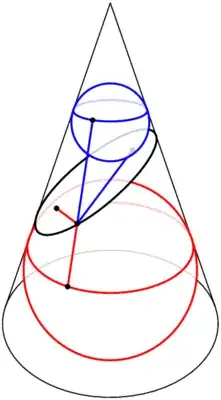We can always find the unique pair of Dandelin spheres from the conic section without ambiguity.
$\hspace{5cm}$
Each Dandelin sphere touches both the right circular cone and the conic section on the corresponding focus.
See also detail discussion with animation in the link here and another post of mine about focal conics and confocal quadrics here.
For a general conic, namely
$$0=
\begin{pmatrix}
x & y & 1 \\
\end{pmatrix}
\begin{pmatrix}
a & h & g \\
h & b & f \\
g & f & c
\end{pmatrix}
\begin{pmatrix}
x \\ y \\ 1
\end{pmatrix}$$
Its foci $z=x+yi$ are given by the complex quadratic, namely
$$Cz^2-2(G+Fi)z+(A-B)+2Hi=0$$
where capital letters $A,B, \ldots$ represent co-factors of the corresponding entries of small letters $a,b, \ldots$ of the matrix respectively. That is
$$
\begin{pmatrix}
A & H & G \\
H & B & F \\
G & F & C
\end{pmatrix}
=
\begin{pmatrix}
bc-f^2 & fg-ch & fh-bg \\
fg-ch & ac-g^2 & gh-af \\
fh-bg & gh-af & ab-h^2
\end{pmatrix}$$
See another post for finding the principal axes, etc.
